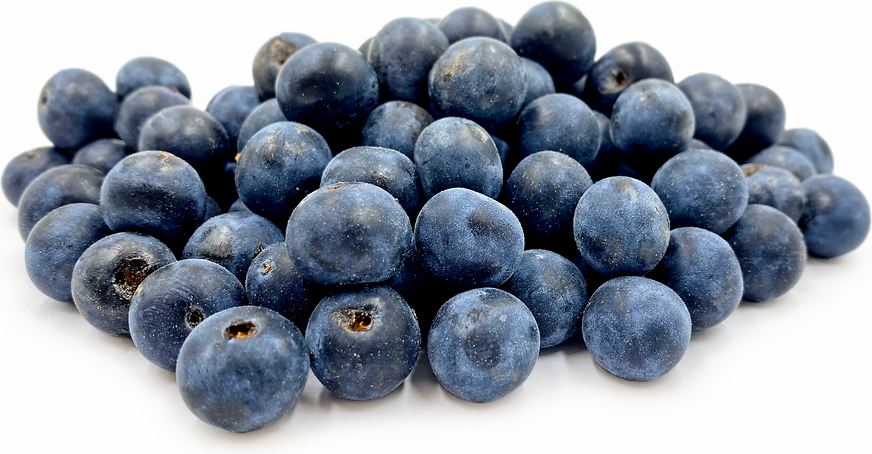


Blackthorn Berries
Estimated Inventory, lb : 0
Description/Taste
Blackthorn berries are small, globular fruits, averaging 1 to 2 centimeters in diameter, and are round to ovate in shape. The skin is smooth, taut, and dark blue, sometimes appearing black, and has a light blue-grey, waxy coating. Underneath the thin skin, the flesh is soft, aqueous, and pale green, encasing a central, inedible seed. Blackthorn berries have a very tart, acidic, earthy, and bitter taste when fresh. If left on the plant and harvested after the first frost, the astringent nature will lessen and become subtly sweet.
Seasons/Availability
Blackthorn berries are available in the fall through early spring.
Current Facts
Blackthorn berries, botanically classified as Prunus spinosa, grow on a dense, thorny shrub or tree that belongs to the Rosaceae family. Also known as Sloe, Thorny plum, and Prickly plum, Blackthorn berry shrubs grow in temperate regions around the world, and the branches extend horizontally, forming very thick, spiny, and long thickets that can live for over one hundred years. The shrub is often used as a property boundary, and in Europe, it is used as a living fence to contain cattle. Blackthorn berries are widely found growing wild and in backyard gardens, and while they are not commonly consumed raw due to their tart, astringent nature, the berries are popularly utilized in jams, baked goods, and fermented for alcohol.
Nutritional Value
Blackthorn berries contain fiber, which can help stimulate digestion, and provide vitamins C and E, anthocyanins, magnesium, and flavonoids. The berries also contain some anti-inflammatory and anti-bacterial properties. In European and Asian folk medicine, the leaves and flowers can be steeped into a tea to cleanse the blood and act as a diuretic.
Applications
Blackthorn berries are best suited for cooked applications such as baking and boiling as the flesh is considered edible but tart when raw. It is also important to note that the seeds inside the flesh are inedible, poisonous, and should be removed. Only the flesh of the berry should be consumed. Blackthorn berries can be cooked into jams, jellies, and compotes, served plain on bread or used in pastries, or they can be made into sauces and served over cooked meats. In Europe, the berries are sometimes used as an ingredient in tkemali, which is a sweet-tart sauce utilized as a condiment. Blackthorn berries can also be covered in chocolate, cooked into a syrup and poured over sorbet and ice cream, preserved in vinegar, or dried for extended use. In addition to food applications, the berries are popularly used in ciders, homemade moonshine, and liquors. Blackthorn berries pair well with fruits such as pomegranate, apples, and oranges, meats such as poultry, beef, pork, turkey, and deer, roasted root vegetables, and potatoes. Fresh berries should be used immediately for the best quality and will only keep in the refrigerator for a couple of days.
Ethnic/Cultural Info
In Europe, especially in the United Kingdom, Blackthorn berries are most popularly used to make sloe gin, which is a liquor infused with Blackthorn berries soaked in gin and sugar to create a tart beverage. Sloe gin has been made for hundreds of years and is a symbol for the fall and winter season, commonly consumed as a festive Christmas drink. Despite its associations with colder weather, sloe gin was also incorporated into a lighter summer drink mixed with soda water and citrus, known as a sloe gin fizz, which is still a well-known gin cocktail consumed today.
Geography/History
Blackthorn berries grow in temperate regions and are widely found around the world. While the exact origins of where the shrub originated are unknown, today, Blackthorn berries are found in Europe, Asia, northern Africa, North America, New Zealand, and Tasmania. The berries are not grown commercially and are a foraged commodity, sometimes sold in local markets.
Recipe Ideas
Recipes that include Blackthorn Berries. One
| Eat Smarter |
|
Blackthorn Jam |
| Fuss Free Flavours |
|
Sloe Syrup - Harvesting the Blackthorn |
| Difford's Guide |
|
Chamomile + Blackthorn Breeze |




